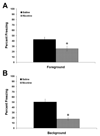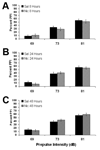Nicotine withdrawal disrupts both foreground and background contextual fear conditioning but not pre-pulse inhibition of the acoustic startle response in C57BL/6 mice
- PMID: 18367257
- PMCID: PMC2409068
- DOI: 10.1016/j.bbr.2008.02.018
Nicotine withdrawal disrupts both foreground and background contextual fear conditioning but not pre-pulse inhibition of the acoustic startle response in C57BL/6 mice
Abstract
Nicotine withdrawal is associated with multiple symptoms such as anxiety, increased appetite, and disrupted cognition in humans. Although animal models have provided insights into the somatic and affective symptoms of nicotine withdrawal, less research has focused on the effects of nicotine withdrawal on cognition. Therefore, in this study, C57BL/6J mice were used to test the effects of withdrawal from chronic nicotine on foreground and background contextual fear conditioning, which present the context as a primary or secondary stimulus, respectively. Mice withdrawn from 12 days of chronic nicotine (6.3mg/kg/day) or saline were trained and tested in either foreground or background contextual fear conditioning; nicotine withdrawal-associated deficits in contextual fear conditioning were observed in both conditions. Mice were also tested for the effects of withdrawal on pre-pulse inhibition of the acoustic startle reflex (PPI), a measure of sensory gating, and on the acoustic startle reflex. Mice withdrawn from 12 days of chronic nicotine (6.3 or 12.6 mg/kg/day) or saline underwent one 30-min PPI and startle session; no effect of withdrawal from chronic nicotine on PPI or startle was observed for either dose at 24h after nicotine removal. Therefore, mice were tested at different time points following withdrawal from 12.6 mg/kg/day chronic nicotine (8, 24, and 48 h after nicotine removal). No effect of withdrawal from chronic nicotine was observed at any time point for PPI. Overall, these results demonstrate that nicotine withdrawal disrupts two methods of contextual learning but not sensory gating in C57BL/6J mice.
Figures





References
-
- World Health Statistics 2006. World Health Organization; 2006.
-
- Acri JB, Morse DE, Popke EJ, Grunberg NE. Nicotine increases sensory gating measured as inhibition of the acoustic startle reflex in rats. Psychopharmacology. 1994;114:369–374. - PubMed
-
- Bast T, Zhang WN, Feldon J. Dorsal hippocampus and classical fear conditioning to tone and context in rats: effects of local NMDA-receptor blockade and stimulation. Hippocampus. 2003;13:657–675. - PubMed
-
- Bell SL, Taylor RC, Singleton EG, Henningfield JE, Heishman SJ. Smoking after nicotine deprivation enhances cognitive performance and decreases tobacco craving in drug abusers. Nicotine Tob Res. 1999;1:45–52. - PubMed
-
- Blanchard RJ, Fial RA. Effects of limbic lesions on passive avoidance and reactivity to shock. Journal of comparative and physiological psychology. 1968;66:606–612. - PubMed
Publication types
MeSH terms
Substances
Grants and funding
LinkOut - more resources
Full Text Sources

